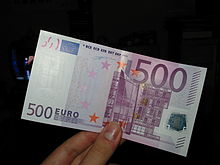Banknote that hides rather than buys is crimes prized payment mechanism
Criminals made £7.5 million of fake Bin Laden banknotes at the end of last year, new figures reveal.
Criminals made £7.5 million of fake Bin Laden banknotes at the end of last year, new figures reveal.
The European Central Bank (ECB) said it had to withdraw that amount of cash in 500 euro denominations from circulation in the final six months of 2016.
The notes, worth £430, are in the process of being phased out because of their association with money-laundering and terror hence the nickname Bin Laden.
While their value makes them a high percentage of the total, they nevertheless made up just under five per cent of all counterfeited notes, the ECB said.
The bank withdrew more than £19.6 million in fake banknotes during the period, 353,000 in total.
The number of counterfeits was “very low” compared with the same period the year before, when the ECB withdrew 445,000 notes.
The 50 euro remained the most counterfeited note, accounting for 42.5 per cent, or £6.47 million, of the total, while 20 euro notes made up 38 per cent of the total, or £2.33 million.
The ECB said it had discovered almost 94 per cent of the counterfeited notes in euro area countries, while 5.4 per cent were other EU member states that do not use the euro as their currency. One per cent of the total was found in other parts of the world.
In May last year, the ECB said it was scrapping the 500 euro note altogether because of the frequency with which it is used to fund crime. The ECB will stop printing the pink notes from 2018.
It is so prized by criminals that it is often traded above its face value, and is used more for hiding things than buying them, French Finance Minister, Michel Sapin, said last year.
It is used more to facilitate transactions that are not honest than to allow you and me to buy food to eat.
A recent Harvard University study also concluded that the notes were the preferred payment mechanism of those pursuing illicit activities, given the anonymity and lack of transaction record they offer and the relative ease with which they can be transported and moved.
A million euros in 500 euro notes weighs just 2kg, compared with 22kg for the same amount in $100 bills. Studies by Europol and the UN Office on Drugs and Crime have also linked them to crime, though the evidence is mainly anecdotal.
Europol which points out that the number of 500 euro notes has multiplied sixfold since the single currencys creation, while the number of 10 and 20 euro notes has remained largely stable went as far as to say the ECB should scrap them unless it could show there was a legitimate use for them.
The links between organised crime and cash are multiple, said Igor Angelini, the head of Europols financial intelligence unit. Criminals need cash at some point in order to cut the trails that could lead back to them.
Some experts have suggested that doing away with the 500 euro note would not be particularly effective in fighting crime anyway.
Organised crime is not stupid, said Friedrich Schneider, an expert on the black economy at Johannes Kepler University of Linz in Austria. Most money is laundered without cash via bogus companies.
Moves to scrap the note, however, have met with stiff resistance in Germany, where an estimated four in five of all transactions are conducted in cash and the ECBs move has been seen as an affront to the nations right to use it.


